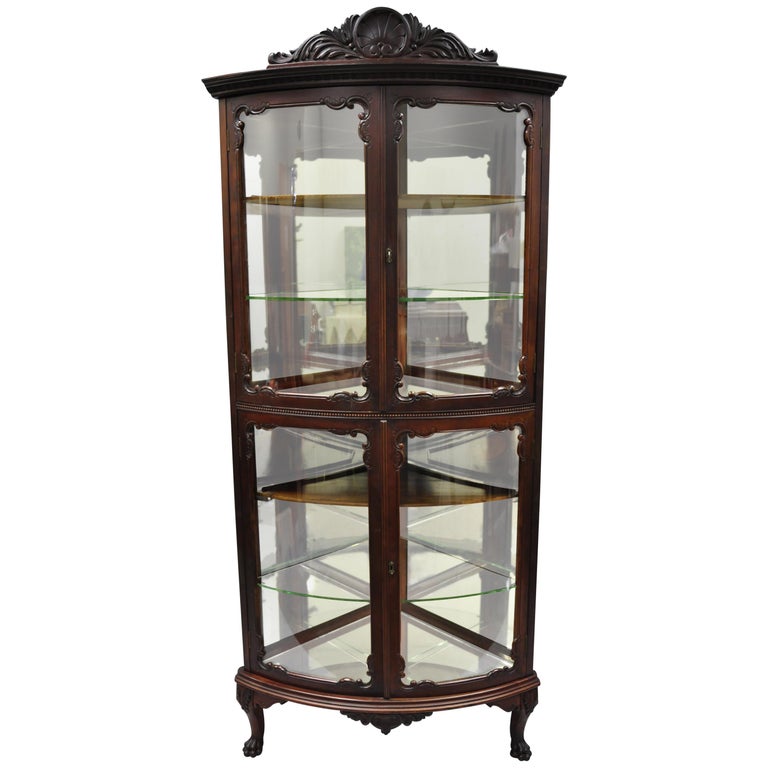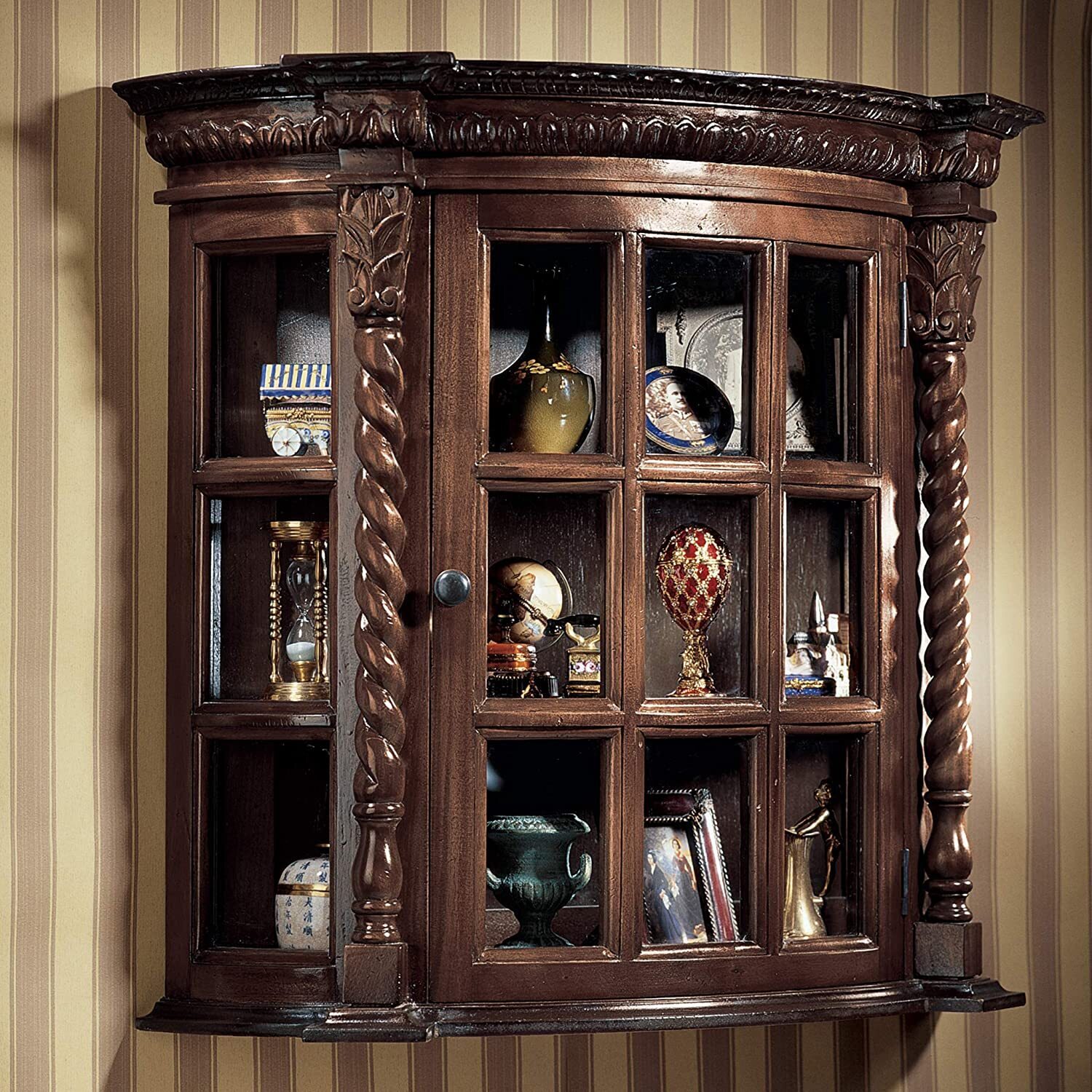The Allure of Victorian Curio Cabinets

The Victorian era (1837-1901) was a period of great social and economic change, and these changes were reflected in the design and use of furniture. Curio cabinets, which were originally designed to display collections of natural history specimens, evolved into status symbols that reflected the wealth and taste of their owners.
The Social Significance of Victorian Curio Cabinets
Victorian curio cabinets served a practical purpose, providing a way to store and display valuable objects. However, they also held significant social meaning. The objects displayed in these cabinets were often seen as symbols of status, education, and cultural sophistication.
- The cabinets themselves were often made of expensive materials like mahogany, walnut, and rosewood, which further emphasized the wealth of the owner.
- The objects displayed within the cabinets were carefully chosen to reflect the owner’s interests and knowledge. These objects might include antique porcelain, exotic shells, rare books, or even taxidermied animals.
- The act of displaying these objects was seen as a way to demonstrate the owner’s refinement and good taste.
The Evolution of Victorian Curio Cabinet Styles
Victorian curio cabinet styles evolved significantly throughout the period, reflecting changing tastes and trends.
- Early Victorian cabinets were often characterized by their simple, functional designs, often featuring gothic revival influences. These cabinets were typically made of dark woods like mahogany or rosewood and were often decorated with simple carvings or metal accents.
- Later Victorian cabinets became more ornate and elaborate, reflecting the increasing popularity of the Aesthetic Movement. These cabinets were often made of lighter woods like oak or maple and were decorated with intricate carvings, painted details, and stained glass panels.
- The use of glass in Victorian curio cabinets also evolved. Early cabinets often featured simple glass doors, while later cabinets incorporated more elaborate glass panels, including stained glass, etched glass, and beveled glass.
The Symbolism of Objects Displayed in Victorian Curio Cabinets
The objects displayed in Victorian curio cabinets often held symbolic meaning.
- Shells: Shells were often seen as symbols of the ocean and the natural world. They were also associated with the idea of travel and exploration, as many shells were collected from exotic locations.
- Porcelain: Porcelain was a popular material for decorative objects in the Victorian era, and it was often seen as a symbol of elegance and refinement. Porcelain figures, vases, and tea sets were common objects to display in curio cabinets.
- Books: Books were highly valued in the Victorian era, and they were often displayed in curio cabinets as a symbol of education and intellectualism. Rare books, first editions, and books on subjects like history, science, and literature were popular choices.
- Taxidermied Animals: Taxidermied animals were often displayed in Victorian curio cabinets as a symbol of the owner’s interest in nature and the natural world. Birds, small mammals, and even exotic animals were popular choices.
Design and Construction of Victorian Curio Cabinets: Victorian Style Curio Cabinets

Victorian curio cabinets were not merely functional pieces of furniture; they were elaborate expressions of craftsmanship, artistry, and the Victorian era’s penchant for showcasing personal collections. The design and construction of these cabinets were a testament to the period’s meticulous attention to detail and the skilled hands of cabinetmakers.
Types of Victorian Curio Cabinets
The Victorian era saw a variety of curio cabinet designs, each with unique features and intended uses. These cabinets were typically made from high-quality materials like mahogany, walnut, rosewood, and oak, and often featured intricate carvings, decorative hardware, and glass panels.
- Display Cabinets: These cabinets were designed primarily for showcasing collections of objects, such as porcelain, china, glassware, or other treasured items. They often featured multiple shelves, glass doors, and elaborate carvings.
- Bookcases: While primarily used for storing books, these cabinets often included glass-fronted sections for displaying decorative objects.
- Corner Cabinets: These cabinets were designed to fit into tight spaces, often with curved or angled fronts. They were often used for displaying smaller collections or personal items.
- Tall Cabinets: These cabinets, often referred to as “tallboys,” were designed for storing and displaying a wide range of objects, from books and china to artwork and personal memorabilia.
Craftsmanship and Techniques
Victorian cabinetmakers employed a range of techniques to create their intricate and durable cabinets. The construction often involved a combination of traditional joinery methods, such as dovetail joints, mortise and tenon joints, and hand-cut veneers.
- Intricate Carvings: Carvings were a hallmark of Victorian furniture, adding intricate details and visual interest to curio cabinets. Carved motifs ranged from floral designs and geometric patterns to depictions of animals and mythical creatures.
- Glasswork: Glass was an essential element in Victorian curio cabinets, providing a clear view of the displayed objects. Cabinetmakers often used hand-blown glass for the doors and shelves, which added a unique character to each piece.
- Hardware: The hardware used on Victorian curio cabinets was often as elaborate as the cabinets themselves. Cabinetmakers used brass, bronze, or silver for hinges, handles, and locks, and often included decorative elements such as finials, escutcheons, and keyhole plates.
Construction Methods
Victorian cabinetmaking techniques differed significantly from modern practices. Victorian cabinetmakers relied heavily on hand tools and traditional joinery methods, which required a high level of skill and craftsmanship. In contrast, modern cabinetmakers often utilize power tools and mass production techniques.
- Hand-Cut Veneers: Victorian cabinetmakers meticulously cut and applied veneers by hand, resulting in a unique and durable finish.
- Traditional Joinery: Victorian cabinetmakers used traditional joinery methods, such as dovetail joints and mortise and tenon joints, to create strong and lasting connections between different parts of the cabinet.
- Hand-Polishing: Victorian cabinetmakers often hand-polished their cabinets using shellac or varnish, creating a rich and lustrous finish.
The Art of Displaying Treasures

Victorian curio cabinets were more than just storage spaces; they were carefully curated displays of personal collections, reflecting the owner’s taste, interests, and social standing. These cabinets were a testament to the Victorian era’s fascination with the natural world, exotic cultures, and the accumulation of knowledge.
A Hypothetical Victorian Curio Cabinet
Imagine a mahogany curio cabinet with intricate carvings and glass doors. Inside, a curated collection of artifacts, books, and other objects tells a story of the owner’s life and interests.
* Natural History: A collection of taxidermied birds, butterflies pinned in shadow boxes, and a fossilized ammonite would showcase the owner’s interest in the natural world.
* Exotic Cultures: A carved ivory tusk from Africa, a hand-painted fan from China, and a set of Japanese teacups would reflect the owner’s appreciation for different cultures.
* Literary Treasures: A first edition of Charles Dickens’s “A Tale of Two Cities,” a signed copy of Tennyson’s poetry, and a leather-bound journal filled with the owner’s own writings would reveal their literary tastes.
* Family Heirlooms: A silver locket containing a lock of hair, a hand-painted portrait of a beloved ancestor, and a family crest would represent the owner’s connection to their past.
* Scientific Curiosities: A magnifying glass, a compass, and a collection of minerals would showcase the owner’s interest in science and exploration.
Objects Commonly Found in Victorian Curio Cabinets
Victorian curio cabinets housed a diverse array of objects, each with its own purpose and historical significance. Here’s a table showcasing some of the most common items:
| Object | Purpose | Historical Significance |
|---|---|---|
| Taxidermied Animals | To showcase the beauty and diversity of the natural world. | Reflects the Victorian era’s fascination with natural history and the rise of taxidermy as a popular hobby. |
| Seashells | To represent the vastness and mystery of the ocean. | Victorian seashells often had symbolic meanings, representing love, prosperity, and good luck. |
| Antique Clocks | To serve as a reminder of the passage of time and to showcase craftsmanship. | Victorian clocks were often intricate works of art, reflecting the era’s emphasis on precision and technical skill. |
| Hand-Painted China | To add a touch of elegance and beauty to the home. | Victorian china was often decorated with elaborate floral patterns, landscapes, and scenes from literature. |
| Antique Jewelry | To showcase personal style and wealth. | Victorian jewelry was often crafted with intricate designs and precious stones, reflecting the era’s emphasis on beauty and craftsmanship. |
Curating a Collection for a Modern-Day Curio Cabinet, Victorian style curio cabinets
While modern-day curio cabinets may not be filled with taxidermied animals, they still offer a unique opportunity to showcase personal collections and tell stories. Here’s a guide on how to curate a collection for a modern-day curio cabinet, drawing inspiration from Victorian aesthetics and practices:
* Choose a Theme: Decide on a theme for your collection, such as travel, literature, art, or family history. This will help you focus your collection and create a cohesive display.
* Embrace Variety: Don’t be afraid to mix and match different objects, textures, and colors. A diverse collection will be more interesting and visually appealing.
* Highlight Personal Stories: Each object in your collection should have a story to tell. Whether it’s a family heirloom, a souvenir from a trip, or a piece of art that holds special meaning, sharing these stories will make your collection even more meaningful.
* Consider Lighting: Proper lighting is essential for showcasing your collection. Use spotlights or LED strips to highlight specific objects and create a dramatic effect.
* Embrace the Unexpected: Don’t be afraid to include unexpected objects in your collection. A vintage camera, a collection of antique buttons, or a piece of found art can add a touch of whimsy and personality to your display.
Victorian style curio cabinets – Victorian-style curio cabinets, with their intricate carvings and glass doors, were often used to display prized possessions and showcase a family’s wealth and taste. While these cabinets often featured dark wood finishes, the modern design aesthetic has embraced lighter tones, as seen in the exquisite craftsmanship of scottsdale cherry java cabinets.
These contemporary cabinets, with their warm cherry wood and elegant java stain, provide a striking contrast to the traditional dark woods, offering a fresh perspective on the timeless appeal of curio cabinets.
Victorian-style curio cabinets, with their intricate carvings and glass panels, were designed to showcase prized possessions. This emphasis on display aligns with the contemporary trend of incorporating black upper kitchen cabinets in modern kitchens, as these cabinets serve as a dramatic backdrop for showcasing culinary tools and fine china.
Just as Victorian curio cabinets were meant to elevate the everyday, black upper kitchen cabinets provide a striking contrast that elevates the kitchen’s aesthetic.
